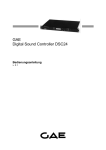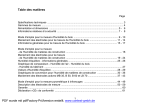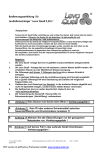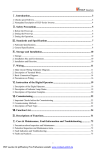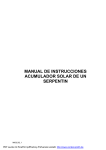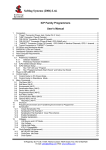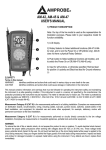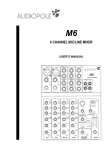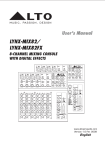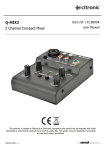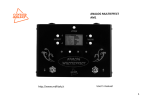Download Technical information press here
Transcript
USER MANUAL PODIUM MXV-P200 SAFE OPERATION AND GENERAL RECOMMENDATIONS Keep away from water and humidity, weather, electrical discharge and strong sun or heat radiation. For adequate cooling the ambient temperature should not exceed 35°C. Do not operate immediately after changing the ambient temperature. Particularly when moving from cold to hot and humid environment, the metal parts and electronic components can be affected by condensed water. Wait for about 15 min. until the PODIUM MXV-P will be adapted to the ambient temperature. 35°C max. Make sure to connect the PODIUM MXV-P to the appropriate supply voltage and quality mains supply. Use the cable that is 230V~ supplied with the PODIUM MXV-P, the connection must be 3- 50-60Hz pole grounded. If you are uncertain about it, grounding should be checked by an expert. To avoid risk of injury (i.e. tripping over cables) or damaging cables and the device, the connected lines should be placed very careful. Do not operate the PODIUM MXV-P and the connected devices near the strong electromagnetic fields and/or high voltage equipment, like emitting antennas (i.e. for instance mobile telephone), large transformers, motors and generators, neon lights. Do not expose yourself to excessive hearing of volume or high sound pressure levels. Be aware of the possible consequences for your hearing. Try allways when possible to place the PODIUM MXV-P effective to improve the listening volume for the audience while reducing the sound pressure level in the near field to the level that is necessary. Normally the PODIUM MXV-P should be placed at the same height as the ears of the audience. For servicing or repair refer to an authorized expert, avoid unauthorized alteration, do not try to open or disassemble any screw or connection. For damages that are caused by unauthorized alteration or misuse we refuse any responsibility. 3 YEAR WARRANTY A.M.P., D-66111 Saarbruecken - Germany, Tel: +49 681 9686881, Fax: +49 681 62495 , www.cromacord.com RCPMXVP200-E001-20030403 * All rights reserved PDF wurde mit pdfFactory-Prüfversion erstellt. www.context-gmbh.de PAGE 1/6 USER MANUAL PODIUM MXV-P200 OPERATING ELEMENTS AND FEATURES 1 Channel 1- volume control with coupled trim gain control (SAGA = Semi automatic gain adjust) 2 Channel 1 - Effect, controls the volume of the signal to be sent to the effect unit 3 Channel 1 - Bass equalizer control 4 Channel 1 - frequency control of the semiparametric mid-frequency equalizer 22 23 1 2 3 4 5 6 7 8 ch1-level eff-send bass mid-freq mid-level treble line PODIUM 9 mic ch4-level ch5-ret. ch2-level eff-send bass treble line Filter master balance 9 5 master-vol 13 10 mic OFF ch3-level eff-send bass treble line ON range 1 11 9 P 200 stereo effect return effect mic 13 5 mode 1 5 Channel 1 - mid-equalizer volume control 6 Channel 1 -Treble equalizer control 7 Channel 1 - Input sensitivity selector of the preamplifier, "mic" for low , "line" for higher input level 26 Channel 3 - balanced 3- pole input socket for 6,3mm jack plug 8 Channel 2 - Bass equalizer control 27 Channel 4 - balanced 3- pole input socket for 6,3mm jack plug 9 Channel 2 - Treble equalizer control 28 Channel 5 - balanced 3- pole input socket for 6,3mm jack plug 12 36 35 21 20 19 18 17 16 15 14 13 10 Channel 2 - Input sensitivity selector of the preamplifier, "mic" for low, "line for higher input level 11 Channel 2 - ffect, controls the volume of the signal to be sent to the effect unit 29 Mix-output of the levels adjusted by the effect controls, "mix"= from the output of the integrated effect device (option),"dry" = without effect or from the input of effect-device. 13 Channel 3 - Treble equalizer control 30 2 preamplifier master outputs before filter equalizer switch and the signal controller/ limiter, "post" = after master volume control, "pre" = before master volume control. 14 Channel 3 - Bass equalizer control 31 Output for extension loudspeaker min. 8 Ohm 15 Channel 3 - Effect, controls the volume of the signal to be sent to the effect unit 32 Mains fuse holder 250V/5x20mm 1 A slow-blow, contains 1 spare fuse for replacing 12 Channel 3 - Input sensitivity selector of the preamplifier, "mic" for low, "line for higher input level 16 Channel 3 - Volume control with coupled trim gain control (SAGA = Semi automatic gain adjust) 33 Mains inlet connector (EN60 320-1 for cold condition) 34 lighting mains power switch 17 Channel 2 - Volume control with coupled trim gain control (SAGA = Semi automatic gain adjust) 35 not in use, reserved for optional upgrading 18 Channel 5 - volume control 37 blind plate 1, reserved for optional accessory module 19 Master volume control 38 blind plate 2, reserved (vid. supr.) 20 Channel 4 - volume control 39 blind plate 3, reserved (vid.supr.) 36 not in use, reserved for optional upgrading 39 38 37 21 Program selector 1 for integrated effectdevice type 0200 Xin-ch1 22 Program selector 2 for integrated effectdevice (option) Xin-ch2 Xin-ch3 ATTENTION ! DO NOT CONNECT ! READ INSTRUCTION TO OPERATE 230V 50/60Hz 1 A T/ LS 8Ω Made in Germany by AMP Acoustic Music Performance 23 Filter-equalizer switch to cut mid -low frequency at 350 Hz master eff-send ch5-ret dry hot pre post mix cold L LS 8Ω R mode ex ON OFF 24 Channel 1- balanced 3-pole input socket for 6,3mm jack plug 25 Channel 2- balanced 3-pole input socket for 6,3mm jack plug Xin-ch4 ch 4 hot cold ch 3 hot cold ch 2 hot cold ch 1 hot cold eff-L-ins eff-R-ins stereo out L ch1-ins in in out out ON OFF prefad R in out ON OFF ON OFF phantom ch 3 34 33 32 ch 2 ch 1 31 30 29 28 27 26 25 24 A.M.P., D-66111 Saarbruecken - Germany, Tel: +49 681 9686881, Fax: +49 681 62495 , www.cromacord.com RCPMXVP200-E002-20030403 * All rights reserved PDF wurde mit pdfFactory-Prüfversion erstellt. www.context-gmbh.de PAGE 2/6 USER MANUAL PODIUM MXV-P200 OPERATION INSTRUCTIONS (page 1) 1. Start position before switching on: In order to avoid unpredictable operation conditions, as idle noise, feedback, distortion, etc. the PODIUM MXV-P should be set to start position before switching on: 19 ,"ch - level" 11, 16 16 , 17, 17 18 18 , 20 20 , "eff-send" 22 , 11 11 , and 15 15 set to 1.1. "master-vol" 19 zero level, left terminal. 3 , 5 9 , 13 13 , 14 14 in position center groove 1.2. Equalizer controls 3 5, 6, 8, 9 10 , 12 12 in position "line" 1.3. Sensitivity selectors 77 ,10 23 in position "off" 1.4. "Filter" switch 23 Now you can switch-on the mains power supply 34 2. Input connection: Depending on the instrument or signal source and the required features, there are different possibilities of using up to 5 instruments at the same time. Plug in the cable to the appropriate input connector : 28 suited for sources and instruments with high output 27 or channel 5 28 2.1. channel 4 27 level, if there is no need to use an internal equalizer and also no need for adding an internal effect to be mixed down, for instance: instruments with preamplifier and/or equalizer, like keyboard, CD player, etc. 25 or channel 3 26 26 for sources and instruments that can not be 2.2. channel 2 25 amplified as stated before 2.1. 24 for sources and instruments, when a semi-parametric mid 2.3. Channel 1 24 equalization is required. 2.4. Channel 1, 2, or 3 suited for microphones with low output level with possibility to make balanced connection with adapter-cable 3-pole jack to XLR-female 3. Adjusting the signal: The individual volume of each channel is to be adjusted with the controls "ch-level" 11 , 17 18, 18 20, 16 17, 20 the required volume of the total mix of the individual channels is to be 16, 19 . adjusted with "master-vol" 19 3.1. Start adjusting the choosen channel and turn clockwise the appropriate control "ch19 until the signal can be heard. Try to adjust or level", as well as the control "master-vol" 19 19 in order to observe the sound quality of limit for your ease the hearing-volume with 19 the output. Turn slowly the control "ch-level" clockwise and increase the volume as long as the signal is clean and undistorted but not over the discontinued mark at the end of the scale. When you begin to perceive any distortion, turn back the control until the distortion disappears. Test the result then also with a signal that could be typically the loudest possible to be expected and repeat the procedure if necessary. 19 to the 3.2. Check now maximum volume performance by turning the control 19 discontinued mark at the end of the scale. If the level is not enough, use one of the channels 1, 2, or 3 for this signal, put the appropriate sensitivity selector to position "mic" and repeat the procedure 3.1. if necessary. 3.3. If desired, adjust the equalizer controls of the appropriate channel at your convenience. Particularly when setting one or various equalizer controls to considerable high amplification gain, it may become necessary to reduce or to readjust the appropriate "ch-level" corresponding to the procedure 3.1. A.M.P., D-66111 Saarbruecken - Germany, Tel: +49 681 9686881, Fax: +49 681 62495 , www.cromacord.com RCPMXVP200-E003-20030403 * All rights reserved PDF wurde mit pdfFactory-Prüfversion erstellt. www.context-gmbh.de PAGE 3/6 USER MANUAL PODIUM MXV-P200 OPERATION INSTRUCTIONS (page 2) 4. Connecting an external effect-device: 29 to the input of the effect-device, as well as it's output to the Connect the socket "eff-send" 29 28 . Adjust at your convenience with "eff-send" 22 , 11 11 , and 15 15 the relative input "ch 5-ret" 28 intensity of the effect for each individual channel. First of all set the appropriate "eff-send" control of the instrument that can be expected to require the highest intensity close to maximum, adjust at your convenience the total mix of the required intensity with the control "ch5-ret" 18 18. Then adjust the required effect-intensity of the other channels with their appropriate "eff-send" controls. . 5. Using the preamp outputs: 30 is delivering 2 independant unbalanced preamplifier The 3-pole "master-out" socket 30 outputs that can be used at the same time with a cable <3-pole jack to 2xmono jack> . Particularly for avoiding hum generated by ground loops, the connection to other amplifiers and devices that are grounded through a 3-pole mains connection (multiple grounded) should be splitted by using a DI-BOX or a suited audio-transformer. 19 it works as if 5.1. The signal of the pin "pre" does never depend on "master-vol" 19, "master-vol" would be set at maximum. The users hearing-volume towards the built-in 19 amplifier can be adjusted independently at any moment with the control 19.This is particularly suitable e.g. when connecting to a P.A. sound reinforcement system, while using the amplifier as active monitor or when connecting to a recording-device while keeping the recording level constant. 5.2. The signal of the pin "post" is always depending proportionally on the control 19 . This is particularly suitable when connecting other amplifiers that will be "master-vol" 19 controlled together as slaves. 6. Connecting extension cabinet: Make sure that the impedance is minimum 8 Ohm and that the technical condition of the speaker-system (i.e. risk of wrong impedance due to failure of a tweeter) and it's cables and connectors ( i.e. risk of short circuit due to damaged components !) is perfect. Plug 31 .Do not the speaker cable (min. 2x0,75mm² diameter) with 2-pole jack into the socket 31 use microphone or instrument cables. A.M.P., D-66111 Saarbruecken - Germany, Tel: +49 681 9686881, Fax: +49 681 62495 , www.cromacord.com RCPMXVP200-E004-20030403 * All rights reserved PDF wurde mit pdfFactory-Prüfversion erstellt. www.context-gmbh.de PAGE 4/6 USER MANUAL PODIUM MXV-P200 TECHNICAL DATA INPUTS: Channel 1 - line/mic -20dB to +6dB / -50dB to -20dB /2x 160KΩ unbalanced, balanced when using 3-pole plug + - 13 dB/ at 100 Hz Bass equalizer + 15 dB/ -13 dB at 1,6KHz (frequency control at middle position) Mid intensity 375 Hz to 5,5 KHz Mid frequency + 12 dB/-15 dB at 10 KHz Treble equalizer post volume control Effect send Channel 2 - line/mic -20dB to +6dB / -50dB to -20dB /2x 80KΩ unbalanced, balanced when using 3-pole plug + - 13 dB/ at 100 Hz Bass equalizer + 12 dB/-15 dB at 10 KHz Treble equalizer post volume control Effect send Channel 3 - line/mic same as Channel 2 -3 dB bis + 7 dB / 2x 60 KΩ Channel 4 - line unbalanced, balanced when using 3-pole plug same as Channel 4 Channel 5 - line OUTPUTS: Master prefader: Master postfader: Master effect: + 16 dB at 10KΩ − or + 4 dB at 600Ω unbalanced, short circuit proof same as master prefader (Option: master outputs can be internally bridged to configure one balanced output) same as master prefader SIGNAL PROCESSING (for internal power amplification): 6 dB cut at 350 Hz Filter switch: fully automatic, dynamic compressor-limiter and signal enhancer Signalcontroller: with dynamic frequency-response-matching and complex selective regulation of up to 30 dB, for best psychoacoustic results of acoustic music instruments and microphones. Power amplification: 60/90/120 Watt RMS 8Ω/RMS 4Ω (with extension speaker- cabinet min.8Ω connected)/music power, protection-circuits against switching-on noise, over-heat and short circuit Speakers: 2-way system with 8" low-mid speaker and dyn. high frequency driver/horn, 98 dB/1W/1m, frequency range 55-20000 Hz Power supply: 230V~/50-60 Hz/ 125 VA, mains fuse 1A slow-blow (can be internally changed to 115V~/50-60Hz/125VA, 1,6A slow-blow) Cabinet: 16mm high-density particle board, spatter finish RAL 4004 (~dark purple-ruby), protective front of perforated sheet metal 1,5mm, prepared to mount optional std. flange for speaker-stand on up to 3 sides/2axis and to add optional protecting hard cover for transportation. Dimensions: 396mm x 290mm x 265mm, Weight:11kg A.M.P., D-66111 Saarbruecken - Germany, Tel: +49 681 9686881, Fax: +49 681 62495 , www.cromacord.com RCPMXVP200-E005-20030403 * All rights reserved PDF wurde mit pdfFactory-Prüfversion erstellt. www.context-gmbh.de PAGE 5/6 USER MANUAL PODIUM MXV-P200 DIGITAL MULTIEFFECT EQUIPMENT type 0200 29 pin "dry" coming from The built-in effect-device is wired internally to the output's 29 11 channels 1 to 3 that are individually adjustable by their appropriate controls 22, 11, 15 and 15. Referring to the programm chart below, the desired effect mode can be 21 The output of the effect-device is selected by using the 16-step rotary encoder 21. 29 and at the same time connected also internally wired to pin "mix" of the socket 29 28 through the switched socket 28 to it's appropriate pin "hot". The intensity of the effect signal returned through channel 5 can be adjusted and mixed to the master 18 signal with the appropriate control 18. 1 2 3 4 5 6 7 8 9 10 11 12 13 14 15 16 Delay 1 Room 3 Room 2 Plate 3 Chorus Plate 1 Room 1 Plate 2 Flange Rotary Speaker Hall 1 Chorus/Room1 Delay 2 bypass Hall 2 Chorus/Room 2 125 ms slapback delay for vocals and guitars Warm room for guitars and rhythm instruments Ambience for acoustic mixes and synth sounds Short vintage plate reverb for snares and guitars Chorus for guitars and pianos Classic plate reverb for lead vocals and instruments Hardwood studio for acoustic instruments Sizzling bright plate reverb for vocals and drums Flanger for jet wash effects Rotary speaker emulation for organs and guitars Bright hall reverb for drums, guitars, and vocals Chorus with reverb for guitars, synths, and pianos. 190ms delay for percussive arpeggios No effect, output signal is a identical digital copy Warm hall for acoustic guitars, pianos and vocals Auto-wah guitar effect reverb for lead instruments Connecting additional effect-devices and combined applications: 28 .The A) The output cable of an external effect-device is connected to the input 28 socket's integrated switch automatically disconnects the internal routing of channel 5 to the internal effect-device. Channel 5 is now receiving only the output signal of the 29 has to be connected to the input of the external device. The output "eff-send" 29 external device by using a 3-pole plug. Connected with pin "dry", the external device receives a signal without effect. Connected with pin "mix", the external device receives the output signal of the internal device. 28 . The 29 is connected to pin "hot" of the socket 28 B) Pin "mix" of the socket 29 internal effect-device can be used as stated before. At the same time the input of an external device can be connected as mode A), it's appropriate output can be returned and individually adjusted through any channel or by various channels.. C) The various combinations proposed before at A) and B) can be selected and controlled externally using a suitable connection device, e.g. a foot switch. Technical data: ADC,DAC: 24 bit, 44,1 KHz, 64x oversampling, frequency range : 20-20000 Hz Noise: -105 dB, THD+N: -95 dB, Input max ! : +10dB/2KΩ , Output: +20dB/10KΩ A.M.P., D-66111 Saarbruecken - Germany, Tel: +49 681 9686881, Fax: +49 681 62495 , www.cromacord.com RCPMXVP200-E006-20030403 * All rights reserved PDF wurde mit pdfFactory-Prüfversion erstellt. www.context-gmbh.de PAGE 6/6







